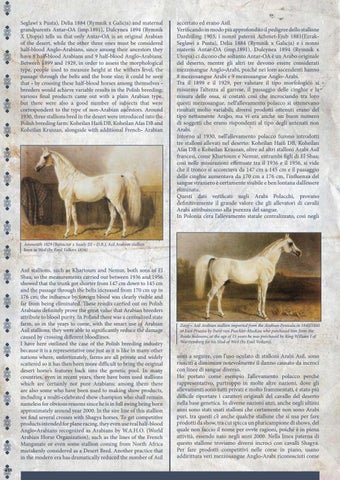Seglawi x Pusta), Delia 1884 (Rymnik x Galicja) and maternal grandparents Antar-OA (imp.1891), Dulcynea 1894 (Rymnik X Utopja) tells us that only Antar-OA is an original Arabian of the desert, while the other three ones must be considered half-blood Anglo-Arabians, since among their ancestors they have 8 half-blood Arabians and 9 half-blood Anglo-Arabians. Between 1899 and 1929, in order to assess the morphological type, people used to measure height at the withers level, the passage through the belts and the bone size; it could be seen that - by crossing these half-blood horses among themselves breeders would achieve variable results in the Polish breeding; various final products came out with a plain Arabian type, but there were also a good number of subjects that were correspondent to the type of non-Arabian ancestors. Around 1930, three stallions bred in the desert were introduced into the Polish breeding farm: Koheilan Haifi DB, Koheilan Afas DB and Koheilan Kruszan, alongside with additional French- Arabian
accertato ed erano Asil. Verificando in modo più approfondito il pedigree dello stallone Dardziling 1903, i nonni paterni Achmet-Ejub 1881(EzrakSeglawi x Pusta), Delia 1884 (Rymnik x Galicja) e i nonni materni Antar-OA (imp.1891), Dulcynea 1894 (Rymnik x Utopja) ci dicono che soltanto Antar-OA è un Arabo originale del deserto, mentre gli altri tre devono essere considerati mezzosangue Anglo-Arabi, poiché nei loro ascendenti hanno 8 mezzosangue Arabi e 9 mezzosangue Anglo-Arabi. Tra il 1899 e il 1929, per valutare il tipo morfologico si misurava l’altezza al garrese, il passaggio delle cinghie e la misura delle ossa, si costatò così che incrociando tra loro questi mezzosangue, nell’allevamento polacco si ottenevano risultati molto variabili; diversi prodotti ottenuti erano del tipo nettamente Arabo, ma vi era anche un buon numero di soggetti che erano rispondenti al tipo degli antenati non Arabi. Intorno al 1930, nell’allevamento polacco furono introdotti tre stalloni allevati nel deserto: Koheilan Haifi DB, Koheilan Afas DB e Koheilan Kruszan, oltre ad altri stalloni Arabi Asil francesi, come Khartoum e Nemur, entrambi figli di El Sbaa; così nelle misurazioni effettuate tra il 1936 e il 1956, si vide che il tronco si accorciava da 147 cm a 145 cm e il passaggio delle cinghie aumentava da 170 cm a 176 cm, l’influenza del sangue straniero è certamente visibile e ben lontana dall’essere eliminata. Questi dati verificati sugli Arabi Polacchi, provano definitivamente il grande valore che gli allevatori di cavalli Arabi attribuiscono alla purezza del sangue. In Polonia c’era l’allevamento statale centralizzato, così negli
Amourath 1829 (Bairactar x Saady III – D.B.), Asil Arabian stallion born in Weil (by Emil Volkers 1856)
Asil stallions, such as Khartoum and Nemur, both sons of El Sbaa; so the measurements carried out between 1936 and 1956 showed that the trunk got shorter from 147 cm down to 145 cm and the passage through the belts increased from 170 cm up to 176 cm; the influence by foreign blood was clearly visible and far from being eliminated. These results carried out on Polish Arabians definitely prove the great value that Arabian breeders attribute to blood purity. In Poland there was a centralized state farm, so in the years to come, with the smart use of Arabian Asil stallions, they were able to significantly reduce the damage caused by crossing different bloodlines. I have here outlined the case of the Polish breeding industry because it is a representative one just as it is like in many other nations where, unfortunately, farms are all private and widely scattered so it has then been more difficult to bring the original desert horse’s features back into the genetic pool. In many countries, even in recent years, there have been used stallions which are certainly not pure Arabians; among them there are also some who have been used to making show products, including a multi-celebrated show champion who shall remain nameless for obvious reasons since he is in full swing being born approximately around year 2000. In the sire line of this stallion we find several crosses with Shagya horses. To get competitive products intended for plane racing, they even use real half-blood Anglo-Arabians recognized as Arabians by W.A.H.O. (World Arabian Horse Organization), such as the lines of the French Manganate or even some stallion coming from North Africa mistakenly considered as a Desert Bred. Another practice that in the modern era has dramatically reduced the number of Asil 438
Zarif – Asil Arabian stallion imported from the Arabian Penisula in 1840/1845 to East Prussia by Furst von Pueckler-Muskau who purchased him from the Roala bedouins, at the age of 15 years he was purchased by King William I of Wurttemberg for his Stud of Weil (by Emil Volkers).
anni a seguire, con l’uso oculato di stalloni Arabi Asil, sono riusciti a diminuire notevolmente il danno causato da incroci con linee di sangue diverso. Ho portato come esempio l’allevamento polacco perché rappresentativo, purtroppo in molte altre nazioni, dove gli allevamenti sono tutti privati e molto frammentati, è stato più difficile riportare i caratteri originali del cavallo del deserto nella base genetica. In diverse nazioni anzi, anche negli ultimi anni sono stati usati stalloni che certamente non sono Arabi puri, tra questi c’è anche qualche stallone che si usa per fare prodotti da show, tra cui spicca un pluricampione di shows, del quale non faccio il nome per ovvie ragioni, poiché è in piena attività, essendo nato negli anni 2000. Nella linea paterna di questo stallone troviamo diversi incroci con cavalli Shagya. Per fare prodotti competitivi nelle corse in piano, usano addirittura veri mezzosangue Anglo-Arabi riconosciuti come
